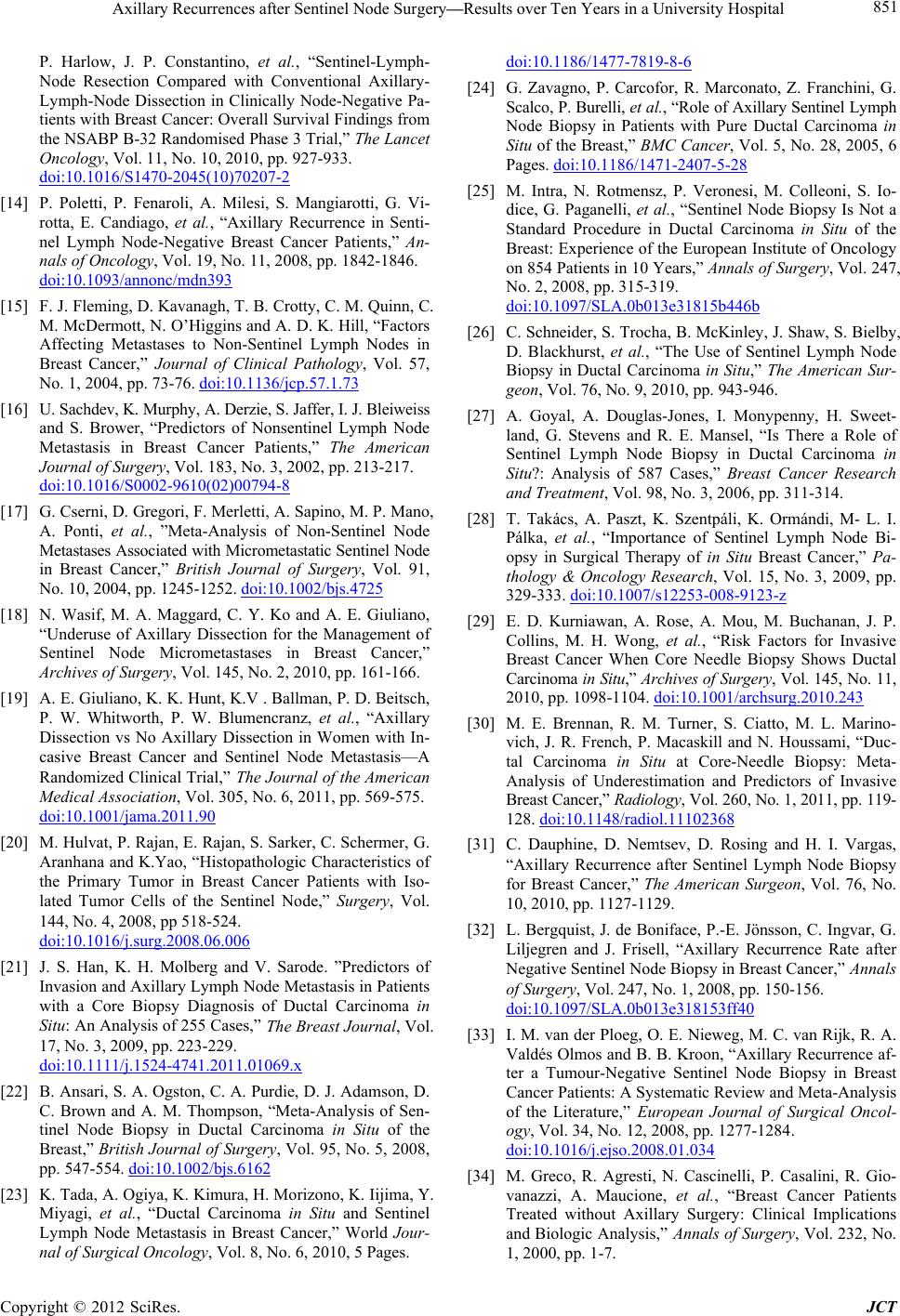
Axillary Recurrences after Sentinel Node Surgery—Results over Ten Years in a University Hospital 851
P. Harlow, J. P. Constantino, et al., “Sentinel-Lymph-
Node Resection Compared with Conventional Axillary-
Lymph-Node Dissection in Clinically Node-Negative Pa-
tients with Breast Cancer: Overall Survival Findings from
the NSABP B-32 Randomised Phase 3 Trial,” The Lancet
Oncology, Vol. 11, No. 10, 2010, pp. 927-933.
doi:10.1016/S1470-2045(10)70207-2
[14] P. Poletti, P. Fenaroli, A. Milesi, S. Mangiarotti, G. Vi-
rotta, E. Candiago, et al., “Axillary Recurrence in Senti-
nel Lymph Node-Negative Breast Cancer Patients,” An-
nals of Oncology, Vol. 19, No. 11, 2008, pp. 1842-1846.
doi:10.1093/annonc/mdn393
[15] F. J. Fleming, D. Kavanagh, T. B. Crotty, C. M. Quinn, C.
M. McDermott, N. O’Higgins and A. D. K. Hill, “Factors
Affecting Metastases to Non-Sentinel Lymph Nodes in
Breast Cancer,” Journal of Clinical Pathology, Vol. 57,
No. 1, 2004, pp. 73-76. doi:10.1136/jcp.57.1.73
[16] U. Sachdev, K. Murphy, A. Derzie, S. Jaffer, I. J. Bleiweiss
and S. Brower, “Predictors of Nonsentinel Lymph Node
Metastasis in Breast Cancer Patients,” The American
Journal of Surgery, Vol. 183, No. 3, 2002, pp. 213-217.
doi:10.1016/S0002-9610(02)00794-8
[17] G. Cserni, D. Gregori, F. Merletti, A. Sapino, M. P. Mano,
A. Ponti, et al., ”Meta-Analysis of Non-Sentinel Node
Metastases Associated with Micrometastatic Sentinel Node
in Breast Cancer,” British Journal of Surgery, Vol. 91,
No. 10, 2004, pp. 1245-1252. doi:10.1002/bjs.4725
[18] N. Wasif, M. A. Maggard, C. Y. Ko and A. E. Giuliano,
“Underuse of Axillary Dissection for the Management of
Sentinel Node Micrometastases in Breast Cancer,”
Archives of Surgery, Vol. 145, No. 2, 2010, pp. 161-166.
[19] A. E. Giuliano, K. K. Hunt, K.V . Ballman, P. D. Beitsch,
P. W. Whitworth, P. W. Blumencranz, et al., “Axillary
Dissection vs No Axillary Dissection in Women with In-
casive Breast Cancer and Sentinel Node Metastasis—A
Randomized Clinical Trial,” The Journal of the American
Medical Association, Vol. 305, No. 6, 2011, pp. 569-575.
doi:10.1001/jama.2011.90
[20] M. Hulvat, P. Rajan, E. Rajan, S. Sarker, C. Schermer, G.
Aranhana and K.Yao, “Histopathologic Characteristics of
the Primary Tumor in Breast Cancer Patients with Iso-
lated Tumor Cells of the Sentinel Node,” Surgery, Vol.
144, No. 4, 2008, pp 518-524.
doi:10.1016/j.surg.2008.06.006
[21] J. S. Han, K. H. Molberg and V. Sarode. ”Predictors of
Invasion and Axillary Lymph Node Metastasis in Patients
with a Core Biopsy Diagnosis of Ductal Carcinoma in
Situ: An Analysis of 255 Cases,” The Breast Journal, Vol.
17, No. 3, 2009, pp. 223-229.
doi:10.1111/j.1524-4741.2011.01069.x
[22] B. Ansari, S. A. Ogston, C. A. Purdie, D. J. Adamson, D.
C. Brown and A. M. Thompson, “Meta-Analysis of Sen-
tinel Node Biopsy in Ductal Carcinoma in Situ of the
Breast,” British Journal of Surgery, Vol. 95, No. 5, 2008,
pp. 547-554. doi:10.1002/bjs.6162
[23] K. Tada, A. Ogiya, K. Kimura, H. Morizono, K. Iijima, Y.
Miyagi, et al., “Ductal Carcinoma in Situ and Sentinel
Lymph Node Metastasis in Breast Cancer,” World Jour-
nal of Surgical Oncology, Vol. 8, No. 6, 2010, 5 Pages.
doi:10.1186/1477-7819-8-6
[24] G. Zavagno, P. Carcofor, R. Marconato, Z. Franchini, G.
Scalco, P. Burelli, et al., “Role of Axillary Sentinel Lymph
Node Biopsy in Patients with Pure Ductal Carcinoma in
Situ of the Breast,” BMC Cancer, Vol. 5, No. 28, 2005, 6
Pages. doi:10.1186/1471-2407-5-28
[25] M. Intra, N. Rotmensz, P. Veronesi, M. Colleoni, S. Io-
dice, G. Paganelli, et al., “Sentinel Node Biopsy Is Not a
Standard Procedure in Ductal Carcinoma in Situ of the
Breast: Experience of the European Institute of Oncology
on 854 Patients in 10 Years,” Annals of Surgery, Vol. 247,
No. 2, 2008, pp. 315-319.
doi:10.1097/SLA.0b013e31815b446b
[26] C. Schneider, S. Trocha, B. McKinley, J. Shaw, S. Bielby,
D. Blackhurst, et al., “The Use of Sentinel Lymph Node
Biopsy in Ductal Carcinoma in Situ,” The American Sur-
geon, Vol. 76, No. 9, 2010, pp. 943-946.
[27] A. Goyal, A. Douglas-Jones, I. Monypenny, H. Sweet-
land, G. Stevens and R. E. Mansel, “Is There a Role of
Sentinel Lymph Node Biopsy in Ductal Carcinoma in
Situ?: Analysis of 587 Cases,” Breast Cancer Research
and Treatment, Vol. 98, No. 3, 2006, pp. 311-314.
[28] T. Takács, A. Paszt, K. Szentpáli, K. Ormándi, M- L. I.
Pálka, et al., “Importance of Sentinel Lymph Node Bi-
opsy in Surgical Therapy of in Situ Breast Cancer,” Pa-
thology & Oncology Research, Vol. 15, No. 3, 2009, pp.
329-333. doi:10.1007/s12253-008-9123-z
[29] E. D. Kurniawan, A. Rose, A. Mou, M. Buchanan, J. P.
Collins, M. H. Wong, et al., “Risk Factors for Invasive
Breast Cancer When Core Needle Biopsy Shows Ductal
Carcinoma in Situ,” Archives of Surgery, Vol. 145, No. 11,
2010, pp. 1098-1104. doi:10.1001/archsurg.2010.243
[30] M. E. Brennan, R. M. Turner, S. Ciatto, M. L. Marino-
vich, J. R. French, P. Macaskill and N. Houssami, “Duc-
tal Carcinoma in Situ at Core-Needle Biopsy: Meta-
Analysis of Underestimation and Predictors of Invasive
Breast Cancer,” Radiology, Vol. 260, No. 1, 2011, pp. 119-
128. doi:10.1148/radiol.11102368
[31] C. Dauphine, D. Nemtsev, D. Rosing and H. I. Vargas,
“Axillary Recurrence after Sentinel Lymph Node Biopsy
for Breast Cancer,” The American Surgeon, Vol. 76, No.
10, 2010, pp. 1127-1129.
[32] L. Bergquist, J. de Boniface, P.-E. Jönsson, C. Ingvar, G.
Liljegren and J. Frisell, “Axillary Recurrence Rate after
Negative Sentinel Node Biopsy in Breast Cancer,” Annals
of Surgery, Vol. 247, No. 1, 2008, pp. 150-156.
doi:10.1097/SLA.0b013e318153ff40
[33] I. M. van der Ploeg, O. E. Nieweg, M. C. van Rijk, R. A.
Valdés Olmos and B. B. Kroon, “Axillary Recurrence af-
ter a Tumour-Negative Sentinel Node Biopsy in Breast
Cancer Patients: A Systematic Review and Meta-Analysis
of the Literature,” European Journal of Surgical Oncol-
ogy, Vol. 34, No. 12, 2008, pp. 1277-1284.
doi:10.1016/j.ejso.2008.01.034
[34] M. Greco, R. Agresti, N. Cascinelli, P. Casalini, R. Gio-
vanazzi, A. Maucione, et al., “Breast Cancer Patients
Treated without Axillary Surgery: Clinical Implications
and Biologic Analysis,” Annals of Surgery, Vol. 232, No.
1, 2000, pp. 1-7.
Copyright © 2012 SciRes. JCT